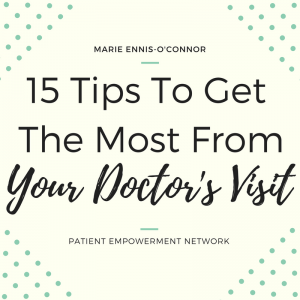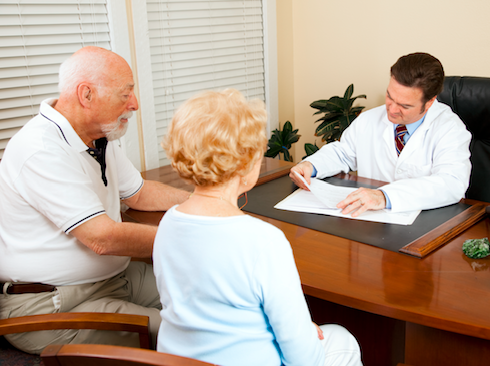How to Weigh Up the Benefits and Risks of Treatment…and Why It’s Important That You Do
Do clinicians have accurate expectations of the benefits and harms of treatments and screening tests?
A new study in JAMA Internal Medicine concludes not. In a systematic review of 48 studies (13 011 clinicians), the researchers found that clinicians rarely had accurate expectations of benefits or harms, more often underestimating harms and overestimated benefits. Among the findings, obstetricians and neurologists underestimated the risk of birth defects from anti-epileptic drugs and GPs overestimated the benefit of prostate cancer screening. Transplant surgeons were biased towards an inaccurately low estimate of graft failure and all types of doctors were unaware of the risk of radiation exposure from imaging.
What do these findings mean for patients? Inaccurate clinician expectations of the benefits and harms of interventions can profoundly influence decision making and the standard of care patients receive. Patient activist, blogger, and author of the upcoming book “Heart Sisters: A Survivor’s Take on Women and Heart Disease” (Johns Hopkins University Press, November 2017), Carolyn Thomas, believes this to be “a consistently systemic issue for patients, too: most believe medical interventions will help more/harm less than they actually do”. It’s a wake-up call for patients who have a critical role to play in understanding and weighing up benefits and risks for ourselves, in order to get better treatment. And it’s a further reminder of the importance of shared decision making to reach a healthcare choice together, as opposed to clinicians making decisions on behalf of patients.
However, understanding the risks associated with a treatment is not necessarily straight-forward. The challenge for busy clinicians is that there isn’t always the time to read and digest the latest research to inform their practice. Medical commentator, physician, and cancer survivor, Elaine Schattner, believes that because medical knowledge changes so rapidly it’s hard for clinicians to keep pace. “This may be especially true in oncology,” she points out, “as patients become expert in their own conditions and needs, they may prefer to look up information on their own, and share their findings with their physicians.”
A lengthy article published this month in ProPublica, examines what it calls “an epidemic of unnecessary and unhelpful treatment” requested by patients and delivered by doctors, even after current research contradicts its practice. “It is distressingly ordinary for patients to get treatments that research has shown are ineffective or even dangerous”, writes David Epstein. “Some procedures are implemented based on studies that did not prove whether they really worked in the first place. Others were initially supported by evidence but then were contradicted by better evidence, and yet these procedures have remained the standards of care for years, or decades.” Epstein points to a 2013 study which examined all 363 articles published in The New England Journal of Medicine over a decade — 2001 through 2010 — that tested a current clinical practice. Their results, published in the Mayo Clinic Proceedings, found 146 studies that proved or strongly suggested that a current standard practice either had no benefit at all or was inferior to the practice it replaced. Of course, this is not to say that myriad treatments don’t indeed improve and save lives, but it’s important to ask questions and do your own research before making a decision on which treatment is the best for you.
Start by asking your doctor to explain all the treatment options open to you, including what would happen if you do nothing. Recognise that all treatments are inevitably associated with some risk of possible harm. Ask your doctor to quantify that risk beyond a purely descriptive term, such as “low risk” (what your doctor considers a small and acceptable risk may be unacceptable to you). Next, do your own research. In order to make an informed decision, you will need to gather reliable information on which to base your choice. Fully exploring the risks and benefits of treatment involves doing your own evidence-based research (using evidence from medical studies that have looked at what happens to many thousands of people with your condition). In a previous article, I shared with you some helpful guidelines for assessing medical information. Most media reports about the benefits of treatments present risk results as relative risk reductions rather than absolute risk reductions, so you will need to understand the difference. Absolute risk of a disease is your risk of developing the disease over a time period. We all have absolute risks of developing various diseases such as heart disease, cancer, stroke, etc. Relative risk is used to compare the risk in two different groups of people. For example, research has shown that smokers have a higher risk of developing heart disease compared to non-smokers. Ask your doctor to differentiate between absolute and relative risk. Check out the NNT website which provides non-biased summaries of evidence-based medicine. “NNT” stands for a statistical concept called the “Number-Needed-to-Treat” – as in “How many patients need to be treated with a drug or procedure for one patient to get the hoped-for benefit?” The core value of the NNT is its straightforward communication of the science that can help us understand the likelihood that a patient will be helped, harmed, or unaffected by a treatment. It provides a measurement of the impact of a medicine or therapy by estimating the number of patients that need to be treated in order to have an impact on one person. Because we know that not everyone is helped by a medicine or intervention — some benefit, some are harmed, and some are unaffected, the NNT tells us how many of each.
You may also want to hear about what other people with your condition have chosen to do and what their experience has been. But remember that just because something has/hasn’t worked for someone else, it doesn’t mean it will/won’t work for you. Orthopedic surgeon, Dr Nicholas DiNubile, recommends patients ask their doctors, “If this were you, or one of your immediate family members, what would you do and/or recommend?” While this may be useful, you must ultimately decide what benefits and risks are important to you. Can you tolerate the side-effects? Are you happy with the way the treatment is administered? Would you find it stressful to live with the risk of any serious side effects, even if the risk is small? What matters is whether you think that the benefits outweigh the risk of any side effects. Everyone is different. The treatment recommended for you may not be the best treatment for your particular lifestyle. Being an advocate for your own health care involves asking lots of questions, doing your own research, and making your preferences known to your doctor. By doing this, you will be better informed and in a stronger position to get the treatment that is right for you.
Related Reading
• Clinicians’ Expectations of Treatments, Screening, and Test Benefit and Harm
• The three questions that every patient should ask their doctor
• Strategies to help patients understand risks

A Stanford Medicine X e-Patient scholar, Marie Ennis O’Connor is an internationally recognized keynote speaker, writer, and consultant on global trends in patient engagement, digital health and participatory medicine. Marie’s work is informed by her passion for embedding the patient voice at the heart of healthcare values. She writes about the experience of transitioning from breast cancer patient to advocate on her award-winning blog Journeying Beyond Breast Cancer.

 Have you ever had the experience of leaving the doctor’s office wishing you had remembered to ask a certain question? Or have you left it until the very end to tell your doctor about the real reason for your visit? These so-called “doorknob” questions – bringing up an important concern just as you are leaving the office – can mean your doctor won’t have time to adequately address your concerns. When the average time it takes for a doctor’s visit is fifteen minutes, it’s easy to feel rushed and forget what you wanted to say, or to leave an appointment unsure of the information you have heard. But with a little advance preparation you can learn how to make the most of those fifteen minutes. Follow these fifteen tips to become a more empowered and engaged partner in your own health – and the health of those you care for.
Have you ever had the experience of leaving the doctor’s office wishing you had remembered to ask a certain question? Or have you left it until the very end to tell your doctor about the real reason for your visit? These so-called “doorknob” questions – bringing up an important concern just as you are leaving the office – can mean your doctor won’t have time to adequately address your concerns. When the average time it takes for a doctor’s visit is fifteen minutes, it’s easy to feel rushed and forget what you wanted to say, or to leave an appointment unsure of the information you have heard. But with a little advance preparation you can learn how to make the most of those fifteen minutes. Follow these fifteen tips to become a more empowered and engaged partner in your own health – and the health of those you care for.


